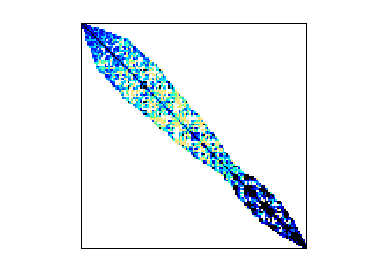Guettel/TEM181302
3D transient electromagnetic modelling, S. Guettel, Univ Manchester
| Name |
TEM181302 |
| Group |
Guettel |
| Matrix ID |
2813 |
|
Num Rows
|
181,302 |
|
Num Cols
|
181,302 |
|
Nonzeros
|
7,839,010 |
|
Pattern Entries
|
7,839,010 |
|
Kind
|
Electromagnetics Problem |
|
Symmetric
|
Yes |
|
Date
|
2015 |
|
Author
|
R.-U. B\"orner, O. G. Ernst, S. G\"uttel |
|
Editor
|
T. Davis |
| Structural Rank |
181,302 |
| Structural Rank Full |
true |
|
Num Dmperm Blocks
|
1 |
|
Strongly Connect Components
|
1 |
|
Num Explicit Zeros
|
0 |
|
Pattern Symmetry
|
100% |
|
Numeric Symmetry
|
100% |
|
Cholesky Candidate
|
yes |
|
Positive Definite
|
no |
|
Type
|
real |
| Download |
MATLAB
Rutherford Boeing
Matrix Market
|
| Notes |
3D Transient Electromagnetic Modelleing, Stefan Guettel, Univ Manchester
The TEM problem relates to the time-dependent modelling of a transient
electromagnetic field in geophysical exploration. The set contains a
matrix pencil (C,M) and an initial value vector q, corresponding to a
Nedelec finite element discretization of Maxwell's equations for the
electric field density e(t). The curl-curl matrix C is symmetric
positive semi-definite and the mass matrix M is symmetric positive
definite. The problem to be solved is a linear initial value problem
M*e'(t) = C*e(t), M*e(0) = q,
for logarithmically distributed time points t in the interval
[1e-6,1e-3].
There are three test sets which are described in the following
publication:
@article{BEG2015,
title={Three-dimensional transient electromagnetic modelling using
rational {K}rylov methods},
author={B{\"o}rner, Ralph-Uwe and Ernst, Oliver G and G{\"u}ttel,
Stefan},
journal={Geophysical Journal International},
volume={202},
number={3},
pages={2025--2043},
year={2015},
publisher={Oxford University Press}
}
The problem details are
TEM27623: section 5.1 in the above paper; layered half-space problem
discretized by 24582 tetrahedral elements of order 1 giving rise to
27623 degrees of freedom.
TEM152078: section 5.1 in the above paper; layered half-space problem
discretized by 24582 tetrahedral elements of order 2 giving rise to
152078 degrees of freedom.
TEM181302: section 5.2 in the above paper; homogeneous subsurface with
topography discretized by 28849 tetrahedral elements of order 2 giving
rise to 181302 degrees of freedom.
In the SuiteSparse Matrix Collection, the primary matrix Problem.A is
the matrix C in the TEM* problems. The M matrix appears as
Problem.aux.M, and the q vector is Problem.aux.q.
|
